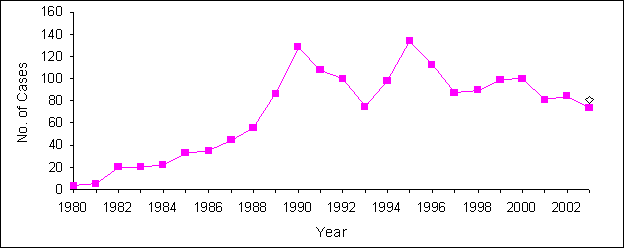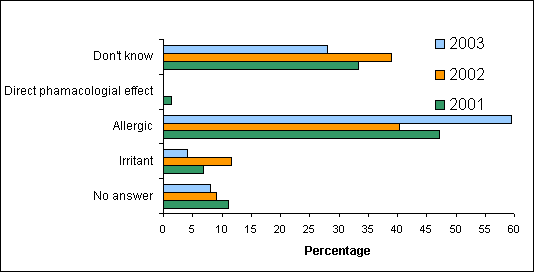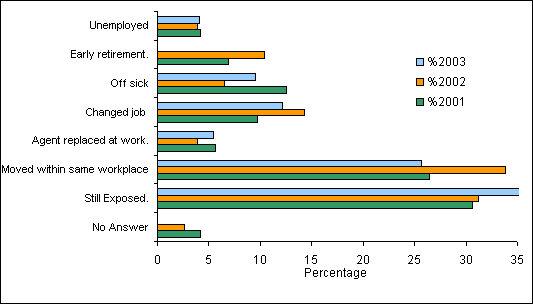Shield Report 2003; A Surveillance Scheme of Occupational Asthma in the Midlands |

|
V Huggins, AS Robertson, JV Drought and PS Burge.
Occupational Lung Disease Unit, Heartlands Hospital, Bordesley Green East, Birmingham B9 5SS.
SHIELD is the Midland Thoracic Society's Surveillance Scheme for Occupational Asthma for the West Midlands. The scheme, which was set up in January 1989, was established to study the general and specific incidence of occupational asthma within the West Midlands region and Metropolitan County. There have been problems with the parent MTS rare disease reporting scheme this year due to data protection issues which has limited reports from outside the Birmingham Chest Clinic. Despite this the rate of reporting has shown little change over the last few years. Seventy four reports have been received so far for 2003.
Eighty seven percent of cases reported in 2003 were by the Birmingham Chest Clinic and 13% by others, which is the same as 2002. We hope to increase the number notified by others this year as consent for Shield data is obtained. The most common method for the diagnosis of occupational asthma still remains a history of improvement of symptoms during holidays or periods off work. Some form of objective confirmation was made in 94% of patients.
The report form now has a place for worker consent for the data to be included on the Shield database. We hope to introduce web-based reporting and feedback this year.
Introduction
Shield was established to meet three main objectives. 1) To study the general and specific incidence of occupational asthma within a defined geographic area, 2) To determine proposed mechanisms of asthma, and 3) to audit diagnostic methods and objectives. Chest physicians and members of the West Midlands Group of the Society of Occupational Medicine implemented the scheme, by reporting each new case using a questionnaire format. The questionnaire covers confidential personal information on the patient, details of the diagnosis, information about their occupational history, and the outcome after diagnosis.
The last report on Shields progress was written in 2002 and summarised the information gained in that year, to that of previous years, 2001 and 2000. This report aims to update the participants of Shield by summarising the trends found in 2003 compared to those found in 2002 and 2001.
Outbreak of the year
This year the foundry making large castings predominantly from stainless steel has again produced the most reports as it did last year. There are two possible causes, isocyanates from the cores (a regular but not very common problem in foundries) and chrome. Several of the affected workers are separated from the core making and casting areas, and chrome fumes generated during powder burning, arc air gouging and welding are the most likely cause. Chrome fumes have been a regular cause of reports to Shield, mostly from electroplating shops. It is likely that the higher than usual level of chrome fumes accounts for this outbreak.
Agent Awareness
Reports of colophony to the scheme has risen dramatically this year from 4% in 2002 to 12% in 2003. Nearly all of the workers who have asthma from this agent are solderers. The introduction of non-colophony solder has still not reduced the number of cases as many companies exclaim, "certain jobs cannot be done with the non-colophony solder". Even the companies who have introduced colophony free solder are still carrying out de-soldering of old circuit boards, which still contain colophony. We have also had a couple of workers with problems with the acid fluxes in the colophony free solder also, so all is not yet resolved.
Shield Data
Number of cases
The number of cases of occupational asthma reported to the Shield scheme is 74 so far. When the SHIELD report for 2002 was written, there were 77 cases notified, but now this figure is up to 84, and is still rising. It is difficult to compare notification for each year properly, as the last few years are likely to change, therefore the graph below is only as a guideline. The diamond shaped point is an estimate of how many notifications of occupational asthma for 2003 there will be by the end of 2004.
Figure 1 Number of cases diagnosed with occupational asthma between the years of 1980 and 2003.

Personal details
In the year of 2003, 74 new cases have been reported to the scheme so far. There were 52 males (70 %), and 22 females (30 %). 60 (81%) of the new cases had no pre-existing asthma, and 29 (39%) had never smoked.
Reporting Hospital and Physician
The Shield scheme is confined to the West midlands Region and the West Midlands Metropolitan County. In this region there are many chest physicians, hospitals, clinics and other organisations, which are known to the Shield scheme. In 2003, 67 (91 %) of the cases reported to Shield were through the Birmingham Chest Clinic, and 7 (9 %) through other organisations. The percentage of cases being reported by the BCC has fallen over the last 4 years, but is now increasing again from 67% in 2001 to 87% in 2002. Solihull hospital and City Hospital are currently the main "other" contributors.
Suspected agents at work
In 2003 the reported agents that the workers were exposed to is similar to 2002. The most common in 2003 and previous years (except 1997) was isocyanates. 362 cases of isocyanate suspected asthma have been reported to the scheme, the first case being in 1978. 21 cases of isocyanate asthma were diagnosed in 2003 and 19 cases in 2002.
The top ten primary agents reported in 2003 were;
- Isocyanates (28%)
- Chrome (22%)
- Colophony/solder (12%)
- Latex (9.5%)
- Biocides including glutaraldehyde (8%)
- Rats/Mice (5.4%)
- Coolant oils (5.4%)
- Cobalt (4.1%)
- Flour (2.7%)
- Wood dusts (2.7%)
Most of these agents were in the top ten of 2002, however, but some of the agents have moved nearer the top of the list, e.g. colophony/solder was previously at number 9. Rats/mice has never featured in our top ten, and chrome is making a come back.
Figure 2 Comparison of the percentage of patients exposed to the top ten agents in 2003 to those exposed in 2002 and 2001.

Employers and Jobs
There were 55 different employers reported to the scheme in 2003. 67% of these were new to the scheme. The major outbreak for 2003 was at a foundry making stainless steel and was due to either chrome or isocyanates. This particular outbreak currently accounts for 22% of all reports in 2003.
Table 1 A list of the most common agents reported in 2003 with the corresponding jobs
| Agent Exposed |
Job |
| Biocides |
Nurse, operating department practitioner, cleaner |
| Chrome |
Fettler, jiggler, welder, powder burner, fork lift truck driver |
| Cobalt |
Machinist, tool setter |
| Colophony |
Solderer, avionics engineer |
| Coolant Oils |
Grinder, press operator |
| Flour |
Baker, flour mill manager |
| Isocyanates |
Moulder, paint sprayer, seamstress, core maker, floral tribute producer, fitter, labourer |
| Latex |
Prison officer, nurse, radiographic helper |
| Rats/Mice |
Physiology technician, animal technician |
| Wood Dusts |
Joiner, pattern maker |
Methods used for diagnosis
The methods used for the diagnosis of occupational asthma vary between each hospital and each physician. The methods that are documented on the shield form are; 1) Improvement on holiday, 2) Improvement off work, 3) Serial peak flow charts, 4) Specific IgE, 5) Non-specific bronchial reactivity at work, and 6) Non-specific bronchial reactivity away from work and 7) Specific bronchial provocation tests. 67 cases were documented as improving off work and on holidays. Of these, 63 cases had at least one other investigation. The most common investigation was serial peak flow charts (55 cases) followed by IgE (38 cases). There were 13 specific challenges in total in 2003 performed on 12 different patients, and of these 11 were done within one year of diagnosis. In 2002, there were 19 specific challenges performed on 13 different patients, with approximately half of these being within one year of diagnosis.
Table 2 Percentage use of each method of diagnosing occupational asthma in 2003, 2002 and 2001.
| Method |
% 2003 |
% 2002 |
% 2001 |
| Improving on holidays |
94.6 |
92.2 |
97.6 |
| Improving off work |
90.5 |
88.3 |
97.6 |
| Serial peak flow |
83.8 |
63.6 |
74.1 |
| Specific IgE |
51.4 |
45.5 |
45.1 |
| Non-specific bronchial reactivity at work |
50.0 |
40.3 |
23.2 |
| Non-specific bronchial reactivity away from work |
33.8 |
26.0 |
34.1 |
| Specific Bronchial Challenge |
9.5 (so far) |
8.4 |
11.1 |
Proposed method of asthma
Figure 4 shows the proposed mechanism of asthma in-patients with diagnosed occupational asthma in 2003, 2002 and 2001. In 2003 the most commonly reported mechanism of asthma was allergic 44 (59.5 %). In 2002 an allergic mechanism was also reported in most cases, however the overall percentage was less (40%). The percentage of the cases where the mechanism is not known is slightly less in 2003 (28%) compared to the previous year (39 %), but the percentage of 'no answer' has decreased again in 2003 compared to last year. The other mechanisms (irritant and direct pharmacological effect) still remain low in the percentage of proposed mechanisms.
Figure 3 Proposed mechanisms of asthma in 2003, 2002 and 2001.

Subsequent History
The subsequent history of the patients diagnosed with occupational asthma in 2003 is very similar to that of 2002 and 2001. A larger significant percentage are still exposed at work, and more are off sick than in 2002. Relocation in the work place has decreased again, but still remains the most popular solution. The percentage of 'no answer' has decreased further from 2001. The recorded subsequent history of the patient is taken at diagnosis and may be changed as investigations occur, this means that the form should be updated and the true outcome for the patients diagnosed with occupational asthma in 2003 will not be seen until possibly the end of 2004.
Figure 4 Subsequent history of patients diagnosed of occupational asthma in 2003, 2002 and 2001.

Gold Standards
A gold standard occupational asthma case is defined by either; 1) Specific bronchial challenge test, 2) A four fold change in their non-specific bronchial reactivity with a good history, or 3) Positive IgE with a good history, and all of these can be accompanied by a good quality PEF record. 11% of cases have become gold standards in 2003 so far, which is similar to the amount in 2002 at this time, but this has now risen to 14.5%. As gold standard notation is dependent upon the results of investigations it is likely that the number for 2003 this will rise over the next year.
Future Developments
The problems with the Shield scheme are still lack of reporting and a need for constant updating. Consent is an issue and we have now changed our form to include this, and a patient information leaflet is now given out. We hope to add email reporting this year, which will mean forms can be downloaded from the computer and updates of Shield can be sent at frequent intervals.
Conclusions
Occupational asthma remains a serious disease causing much morbidity, and is potentially preventable. The Health and Safety Executive are currently emphasising the need to sort out occupational asthma. Healthcare personnel amongst others are a high risk group for the development of occupational asthma.
Comments
Please sign in or register to add your thoughts.